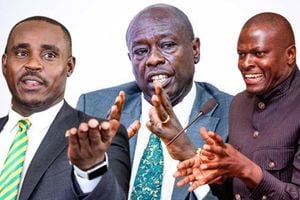An IDP is just that, whether ‘encamped’ or ‘integrated’
What you need to know:
- IDPs are the enduring reminder of the shame of post-election violence, something the Jubilee Government has been trying to put as much distance from itself as possible.
- Unfortunately, it appears government has decided to address the question of IDPs through propaganda, making it difficult to engage in a constructive dialogue on this question.
Recently, more than 1,000 internally displaced persons marched from Konate to Nyamira town, to press for recognition and similar treatment as IDPs in other parts of the country.
Organised by leading Nairobi-based human rights organisations, the IDPs met with and presented a memorandum to the Nyamira County Commissioner Wilson Wanyanga, who promised to take up their grievances with the President. Also present was Governor John Nyagarama.
The plight of the Nyamira IDPs supports allegations that have been flying around, since the Mwai Kibaki days, of discrimination in the provision of assistance to IDPs.
The fact that most of the “integrated” IDPs are from the west of the country, and are part of the group that has alleged discrimination in the past, leads to the fear that the government has chosen to ignore IDPs from that part of the country.
A report in early 2013, by Human Rights Watch, which followed a study in Nakuru and Uasin Gishu, documented claims of preferential treatment for IDPs based on ethnicity. This same assertion had been made in 2011, to the parliamentary committee on internally displaced persons.
The government has never denied allegations of ethnic discrimination, but has reiterated that it is committed to serving all IDPs equally.
A recent letter by the Victims’ Legal Representative in the case of ICC vs Uhuru Kenyatta, Mr Fergal Gaynor, to United Nations Special Rapporteur on the Human Rights of IDPs, Dr Chaloka Beyani, noted that “tens of thousands of ‘integrated’ PEV IDPs who fled to the Western and Nyanza regions of Kenya … still live in abject poverty”.
The Nyamira IDPs demanded, in particular, to be paid Sh410,000 each, which they said IDPs in other parts of the country had received.
During his visit to Kenya in May, Dr Beyani issued a statement to the effect that “causes of internal displacement are many and recurrent, and solutions must be pursued more rigorously for all IDPs in an equal manner.”
The official position of the Jubilee Government is that there no longer are IDPs in the country as they have all been resettled. However, this assertion is challenged by independent information, and the march in Nyamira also contradicts the government position. The rapporteur also appeared to question the government’s view, declaring that “the end of displacement cannot be determined by a political decision, but by reality, and durable solutions are only achieved once IDPs can enjoy their human rights without discrimination.”
IDPs are the enduring reminder of the shame of post-election violence, something the Jubilee Government has been trying to put as much distance from itself as possible. Unfortunately, it appears government has decided to address the question of IDPs through propaganda, making it difficult to engage in a constructive dialogue on this question.
First, the government made a declaration that all IDPs had been resettled, a declaration whose basis remains unclear and that is manifestly untrue.
“Integrated” IDPs
Second, the government has adopted an ever-changing definition of who an IDP is. As a result, and contrary to Kenyan law, the government has refused to recognise or address, the plight of “integrated” IDPs. Following their displacement by the PEV, many of these were transferred to, and dumped in, parts of the country regarded as their ancestral homes.
While a large number of those transported to the Rift Valley and Central Kenya settled in camps, most of which have since been disbanded, those transported to the Western and Nyanza regions settled among communities rather than in camps, and are now referred to as “integrated” IDPs, a misleading term and one which understates the squalor in which they live.
Mr Gaynor’s letter pointed out concerns which he asked the rapporteur to take into account in his engagement with Kenya. These include the continuing differentiation by the government between “encamped” and “integrated” IDPs, which has led to compensation being offered to the former but not the latter.
Third, the government has represented information about IDPs in a misleading manner and has, for example, passed off evictees from the Mau Forest, who have since been compensated, as post-election violence IDPs.
President Kenyatta’s State of the Nation address in April claimed that Sh440,000 had been paid to each of the 8,298 families of IDPs. This is the number of forest evictees paid off. His speech had the effect of blurring the clear divide between IDPs from the PEV and forest evictees.
In all this, some responsibility must be apportioned to the political leaders in the parts of the country, like Nyamira, where IDPs have been forgotten. These leaders are in a position to champion local IDP issues but have failed to do so. It is to be hoped that the renewed advocacy will raise interest and bring a semblance of equal treatment for IDPs in these areas. `
If the government cared, the report of the Truth Justice and Reconciliation Commission contains a chapter on reparations, which could guide official approaches to reparations on “integrated” IDPs.
In several places, the President has talked about national reconciliation. This welcome aspiration is, however, unattainable if the country continues to ignore the suffering of a category of its citizens as a result of the PEV.
The government must engage, in good faith, on the IDP question, and needs to recognise “integrated” IDPs whom it should resettle and compensate. The government must end discrimination in the treatment of IDPs, and strive to provide verifiable information to support its various claims regarding the handling of the question of IDPs.





